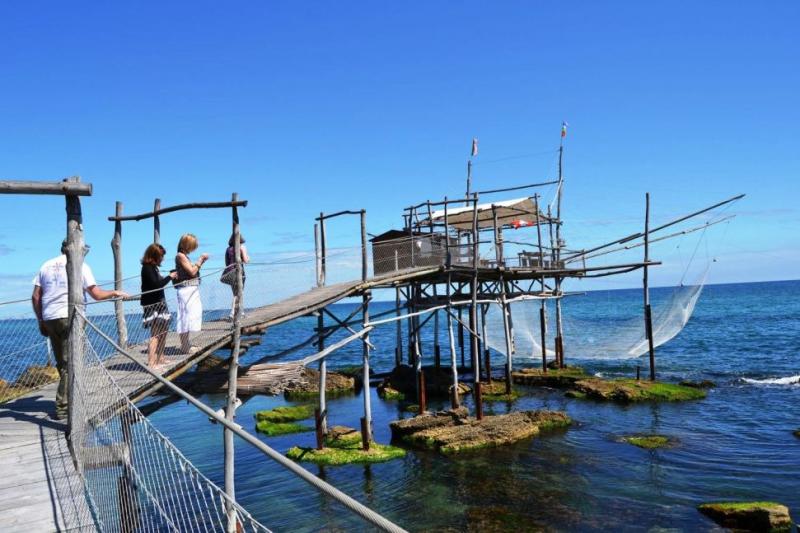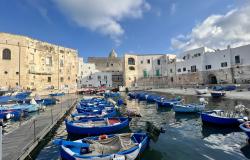When I was a child, every evening my mum and my grandmother sat in religious silence to watch Colonel Bernacca's weather forecast on RAI 1. "He was the best!" they used to say. What stuck in my mind was the fact that Bernacca always indicated L'Aquila, Abruzzo's capital, as the coldest city in Italy. Couple this with the region's fame for its mountainous national parks and reserves protecting Marsicani bears and wolves, and you can see why I grew up thinking of Abruzzo as just the land of shepherds with flocks of sheep grazing around Medieval villages and castles.

However, the first time I met an Abbruzzese, it took me only seconds to realise how much more there is to this region. Andrea is a real seafood gourmet, as a university student he split his time between studying and cooking; his home-made pasta with mussels and clams needed no further explanation. He told me everything about his hometown, San Salvo, and the Costa dei Trabocchi, a stretch of coastline in the province of Chieti dotted with trabocchi, traditional wooden fishing machines. He was enthusiastic about this ingenious fishing technique which did not require knowledge of sea navigation, "noi siamo gente di montagna, ma siamo furbi e sappiamo governare anche il mare" ("we are mountain people, but we are smart enough to master the sea as well") he used to tell me. By then I knew that sooner or later I would have to visit this area of Abruzzo where 'shepherds and farmers' conquered the sea.
When I met Fabrizio and Gianlorenzo of ItaliaSweetItalia who run special tours of the region and know everything about the Costa dei Trabocchi, I was ready for a true taste of Abruzzo's coastline.

'The best way to explain a Trabocco is to show you one', Fabrizio explained. So on my first day in the area, we headed towards Rocca San Giovanni to visit Maria and Rinaldo at the Trabocco Punta Tufano. It was an early spring day, the wind rocked the trabocco and while we were approaching this strange stilt house with its antennas, it looked like a big prehistoric insect coming out of the sea ready to eat us. 'Now you understand Gabriele D'Annunzio - a famous Italian poet who was born in Abruzzo- described them as 'ragni colossali' (colossal spiders)', Gianlorenzo told me.
While Maria welcomed me and showed me an amazing selection of fish she was going to cook for us on the Trabocco, I knew I was in good cooking hands. In the meantime, Rinaldo, Fabrizio and Gianlorenzo explained the history of this incredible structures.

The earliest documented existence of Trabocchi dates back to the 18th century, but it probably goes back to Phoenician times. "What is sure is that they were invented by farmers and not by fishermen", Rinaldo explained. "La fame spinge il lupo fuori dalla tana! (hunger pushes a wolf out of his den) so our ancestors understood that when the crop was poor, they could also harvest the 'fruits of the sea' and came up with a system that was safe and easy for them."

In Abruzzo, a trabocco, is usually built using beams of oak, spruce and Aleppo pine. It is a platform, connected by a bridge to the coast, with long arms called antenne. These antenne stretch out, suspended some meters above the sea and support a narrow-meshed net called trabocchetto (trap). The fishermen retrieve the fish from the bottom of the net whilst it is still lying in the water using a long sieve like a scoop.
Gianlorenzo, pointed out that the technique also spread to Molise and the Gargano peninsula, in Apulia, 'but it was first invented in this area!' added Rinaldo proudly.
Before World War II, fishing from a trabocco could support up to 4-5 families, but they have since lost their economic function. Lately, they have acquired a cultural role becoming an architectural symbol of the area and a tourist attraction.
'True, now we take people who come from other parts of Italy or from abroad here. But we do not see people as tourists, rather as guests who come to share a moment of their life with us. They come to find out about our history and help us to keep some traditions alive', Fabrizio explained.
Today many trabocchi are either used as small restaurants 'on the sea' or just as a special place to enjoy with families and friends over the weekend.

The trabocco I was on, the Trabocco Punta Tufano, has been in the Verì family since the late 1700s, though most of it was reconstructed in 2006 after a storm caused major damage to the original structure.
Maria gives cooking classes and prepares excellent traditional food with fresh fish supplied by local fishermen; octopus with polenta, brodetto alla vastese (a special fish soup), fresh anchovies, marinated clamps, stuffed mussels. And it is not just about fish, she also prepares a traditional dessert, looking like the ancestor of waffles, 'catarrette', also known as ferratelle, pizzelle, cancellate and neole, served with jam made by Rinaldo and Maria with local citrus.

'We like they way our guests react to a day on a trabocco, they usually fall in love with Maria's cooking, the history of the place and the surrounding nature. They like to sit back, breathe in the sea breeze and relax. We also take guests who like painting for special sessions on the trabocchi. And we always discover new lights, new charming aspects of these incredible 'time machines' through their eyes.'


As Fabrizio and Gianlorenzo take their guests to also visit many other areas of Abruzzo, taste wine and extra virgin olive oil, learn how to make fresh 'spaghetti alla chitarra', make ricotta and cheese, at the end of my visit I was taken to a farm to milk a sheep. 'We do not want to disappoint you, you thought Abruzzo was all about shepherds and their sheep, here you are now. That was the funniest way to get me back for my preconceptions on Abruzzo and my old friend Andrea was truly proud of them when I told him!
Gianlorenzo and Fabriozio set up a special Trabocchi Tour which includes a cooking class with Maria and a special dinner on Trabocco Punta Tufano.
To take advantage of this exclusive offer click here





